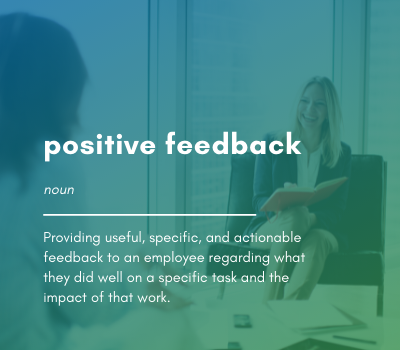How to give positive feedback and lead your team to success
 When it comes to giving positive feedback, it can require a new way of looking at things. There’s an old adage that says “no news is good news.” But we’ve come to learn that’s not necessarily the case. No news might just mean that the bad news hasn’t come to your attention yet, not that it isn’t brimming beneath the surface. After all, that’s why we get car inspections, go to annual checkups, and have annual performance reviews.
When it comes to giving positive feedback, it can require a new way of looking at things. There’s an old adage that says “no news is good news.” But we’ve come to learn that’s not necessarily the case. No news might just mean that the bad news hasn’t come to your attention yet, not that it isn’t brimming beneath the surface. After all, that’s why we get car inspections, go to annual checkups, and have annual performance reviews.
Today, we know that effective feedback on an employee’s performance is important. How do employees know if they’re doing a good job? Do they need to make a few adjustments? What if they’re doing an overall bad job? Without feedback, everyone’s working blindly.
Quite a bit has been written about providing negative (or better referred to as constructive) feedback. However, positive feedback is just as important for maintaining employee engagement, building a healthy company culture, and building on an employee’s strengths. And if done wrong — it can actually be quite harmful.
Why is positive feedback important?
There’s a common misconception that people want positive feedback simply for affirmation. It’s something given to make people feel good, and it’s perhaps even looked down upon. “They need me to tell them they’re doing a good job!” While it’s true that most people do like to be recognized for their hard work, that’s not the only reason that positive feedback is a key part of a healthy work environment.
Positive employee feedback is vital in every work environment for both employees and businesses to thrive. It takes the guesswork out of the workplace, acknowledging when an employee does good work, and encouraging them to do more of it.
Giving constructive feedback is good too, but it’s not enough to just alter behaviors that aren’t going well, you also need to reinforce things that are to get the most out of your team. Otherwise, they’ll be left to keep guessing whether they’re doing a good job or not and may stray even further from the right path.
Imagine that you’re a project manager, and you’ve been using the same process since you started. However, for this new project, you make some process improvements that you think will smooth out some pain points you identified. The project goes on, is finished, and you hear nothing out of the ordinary. Should you keep implementing the new way or go back to the old way? Great question. If you want an employee to keep replicating good behaviors, you must tell them.
What is positive feedback?
Before we continue, it’s important to establish what we mean by positive feedback. For the sake of this exercise, I’d like to define positive feedback as “Providing useful, specific, and actionable feedback to an employee regarding what they did well on a specific task and the impact of that work.”
To better define this, let’s look at two examples.
Example 1:
Picture yourself coming into a check-in with your boss. “You’re doing a great job!” they say “You’re a really valuable member of the team!”
This might be heartwarming to hear (perhaps), but it’s not exactly helpful. Based on our definition here, this is not positive feedback. They’re words of affirmation, yes, but they’re not useful, specific, or actionable.
Example 2:
Picture yourself coming into the same meeting with your boss. As you’re going over your notes, they say “You’re really doing a great job managing this project right now. Your excellent attention to detail has kept things moving quickly and you managed to catch a few errors that could have pushed back our timeline if not addressed quickly.”
That’s positive feedback. The employee understands what they did well and can replicate it. Even better, they know why it’s important. If they didn’t catch those errors early, the whole timeline for the project could have been impacted. Better keep doing a detailed review early on in the process.
 How to deliver positive feedback
How to deliver positive feedback
It’s pretty simple, but when done poorly, it can actually be more harmful than good.
Be specific
The key to positive feedback is to make it specific and actionable. In the first example given, simply expressing that an employee is doing a great job and is a valued team member is great for a holiday card, but not useful as actionable feedback.
In the other example, we talked about how they performed well on a specific project. Even better, it tells them how they did well — their attention to detail was valuable. Why? It kept things moving quickly and helped catch errors that could have delayed the project.
Excellent. This employee now understands what to keep doing. In a formal review, you could even go a step further and have more tangible examples.
“The way you sent weekly updates on the project status to the whole team ensured all the key stakeholders stayed up to date on changes to deadlines and anything that needed quick approval.”
“Because of your attention to detail when reviewing the proposal before it went out, we were able to catch a few mistakes where updates weren’t made to the final document before it was sent out to the client.”
Those are specific and actionable examples of feedback an employee can now take and apply to future work.
Be genuine
People are better at reading you than you probably realize. That’s why it’s vital that when you give positive feedback, it’s genuine. When you’re being honest, your body language is going to reinforce your words. We’ve all heard someone say something positive before, while their tone and body language are telling us a completely different message.
If you don’t have something positive to say, then don’t pretend. It’ll be obvious and leave everyone feeling worse afterward.
Do it one-on-one
Feedback is sensitive, even when it’s good. Congratulating someone for hitting a milestone in front of the whole team is probably fine in most cases, but feedback is personal. You want to leave room for more discussion. Maybe they want to ask for additional insights or talk about a specific aspect of the project or your feedback. This is better suited for a one-on-one than in a team meeting or group setting.
Additionally, giving feedback in front of a group, even a small one, can make the subject self-conscious and uncomfortable. Many people don’t like such high-profile recognition. It even could make other team members jealous or self-conscious. Why didn’t I get any positive feedback for putting in extra effort too?
Don’t use the feedback sandwich
We’re all familiar with the feedback sandwich, and for a long time, managers thought it was the best option. Slap the negative feedback in between two positive comments and it’ll soften the blow. But it’s really not the best way to achieve your goal.
-
The sandwich feels contrived. Just about everyone is familiar with this now, when someone sees it, they know what to expect. It cheapens the positive feedback, you’re giving it because you have to follow the method, not because you want to. It’s nearly impossible for it to sound genuine in this case.
-
It cheapens both the positive feedback and constructive criticism. The value of the positive feedback gets lost in the sandwich. However, it also can distract from and lighten the constrictive criticism. Critical feedback should be delivered confidently, not hidden within the layers of a sandwich so you can barely taste it.
That doesn’t mean that you can never do both. It’s perfectly reasonable to discuss the positives and negatives of a particular project and an employee’s performance during it. However, be sure it doesn’t contrived and that you give both positive feedback and constructive feedback the time and attention they deserve individually.
When positive feedback can go wrong
It may sound counterintuitive that positive feedback can be bad, but bear with me. When positive feedback is too general and shallow, it can come off as fake and contrived.
“You’re doing great, Sue!” doesn’t feel so authentic. Even worse, it can feel sarcastic or forced. How am I doing great? Did they really mean that? Maybe they weren’t happy with my performance on this project? What am I doing great on?
Additionally, an employee could easily misinterpret something so general. Maybe they think you meant they’re doing great on something that you actually think they could improve on. Oops. Or maybe they think that you’re not really invested in them and their work. After all, you couldn’t take a few moments to explain why they’re doing great?
With specific and detailed feedback, you take the guessing game out and make the feedback appear authentic — because it probably is authentic.
When to give positive feedback
What time is appropriate for giving positive feedback will vary from team to team and organization to organization, but there are a few general guidelines.
- Give positive feedback as frequently as it feels authentic. Don’t force yourself to say something positive if you don’t mean it. If an employee is doing great work, let them know.
- Don’t go overboard. If you give positive feedback 4 times a day, or in every email, it might start to lose its effectiveness. It’s no longer special and it’s hard to know which bit of feedback was most valuable and that they should remember.
- Don’t do it too infrequently. After all, the purpose of positive feedback is to help someone learn what they’re doing well and what they should keep doing. If you save it for an annual review, that’s probably too late. You’ve let a year go by without giving much direction.
- Do so in a timely manner. Reinforcing positive behavior isn’t helpful months after the fact. Provide positive feedback while it’s still fresh.
What the cadence is, however, will depend on you. If you have weekly meetings with your direct reports, then that’s a good time to give feedback — positive or negative. Otherwise, you might have one-off conversations here and there. If you don’t have regular meetings (though you probably should), then it would be a little awkward to call a meeting just to congratulate someone on handling a project well.
So in short — do what feels natural for your team. If you don’t have any genuine positive feedback to give someone on your team every couple of weeks, then there are probably larger problems that need to be identified. Don’t cheapen it by going overboard, but don’t withhold it either — positive feedback is a tool for steering your team in the right direction, not just for making them feel warm and fuzzy.
In summary
Providing positive feedback may have a reputation for being just warm and fuzzy in some businesses. However, in truth, it’s a vital leadership skill that should be part of any leader’s toolkit. Being shown appreciation when an employee goes the extra mile is nice. Receiving feedback on how things are going is a vital part of performance management.
If you’re not used to providing positive feedback, then it’s never too late to start getting in practice. It’s a great way to expand your communication skills and lead your team to success.








